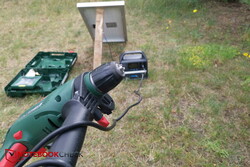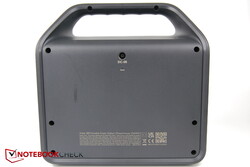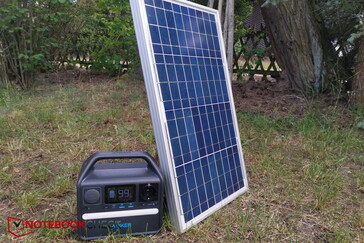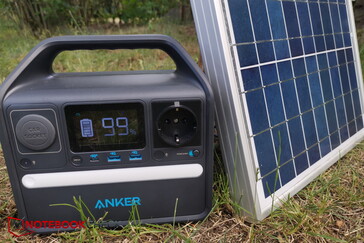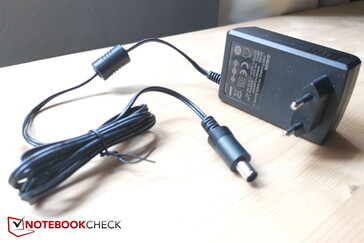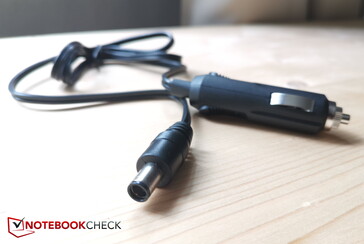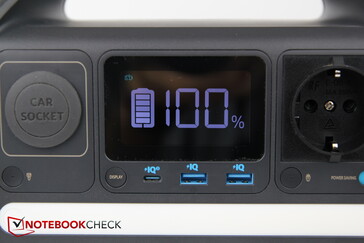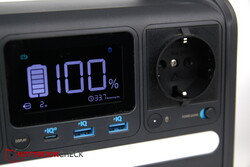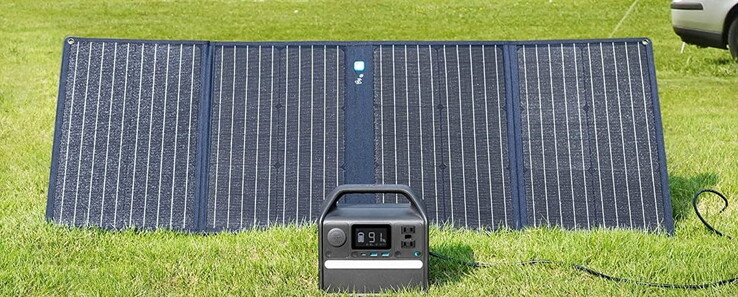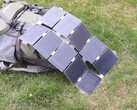Introduction
If you're on the road for more than a weekend, a normal power bank might not be enough for intensive smartphone use, and if you also want to charge your laptop on the road, it won't be enough anyway. Do you want to operate a cool box on warm summer days or beam films onto the walls of a house using a projector, away from any power outlet? Writing Notebookcheck articles at the lake instead of in the dark home office (completely fictional situation)? Something bigger is needed. A portable power station.
Power Stations are the mega power banks for on the go, with the difference that they have much larger batteries. But more importantly, unlike conventional power banks, they also have an integrated inverter that can convert the battery's 12 V direct current into 230 V alternating current.
In addition to the obligatory USB outputs for charging a smartphone, these power stations also offer a full-fledged socket that supplies power to normal devices with 230 V plugs. In this way, you can charge your laptop, connect a toaster or operate a projector or TV at the Power Station while you're on the road.
Power - At 200 W with limitations
However, there is already the first restriction to consider, because depending on the battery size, not every device can be operated - there is a power limit above which the battery of the respective Power Station is overtaxed.
In the case of the Anker 521, this limit is 200 W. Anker also offers larger (and more expensive) Power Stations, which allow devices with an even higher power. The 521 model is currently the smallest Power Station with a 230 V socket at Anker and in this case, only devices that consume a maximum of 200 W may be connected.
It should also be noted for power station beginner-users like me that devices sometimes require an even higher starting power. For example, a device can run with 150 W, but it needs a starting peak power of 500 W, which only needs to be applied in the millisecond range. However, since Power Stations do not allow more than the specified power, they then refuse to work because the Power Station automatically switches off with more power consumed.
Thus, you cannot use an electric heater with the Anker 521. But you can power your own laptop, as long as it is not a gaming monster with a power consumption of more than 200 W. For example, the Razer Blade 17 with RTX 3070 Ti could just exceed this limit (under maximum load only). You can still charge it since it does not consume anything when turned off. But you could also run an economical projector on the Anker for a movie night when no power outlet is available. There are countless other use cases such as operating a WLAN router, charging a phone, drone, electric tools, etc.
Charging - Solar panel, power supply or car plug
If you also have a solar panel, you can recharge the Anker 521 yourself, even at the same time as the current is drawn by a consumer. You should definitely pay attention to this when buying a model; until recently, charging with a simultaneous current draw was by no means a matter of course and some inexpensive alternatives may still lack this important feature.
Unfortunately, there are also performance limits when it comes to charging the power station. The Anker 521 can be charged with a maximum of 65 W, both via solar panel and via the included adapter. The additional power of a 120 W panel in optimal sunlight would then simply fizzle out.
In my case, I only had a 30 W panel at hand, which charged the PowerStation quite reliably with around 22 W. However, a folding panel with around 100 W would probably be optimal for mobility, so that you can still charge well in less optimal solar conditions. Anker has been offering such a folding panel since June 10, but these types are still much more expensive than standard panels. The Anker 625 folding solar panel costs around 330 Euros. Static, i.e. fixed 100 W panels without a folding mechanism are already available from around 120 to 130 euros.
Both panel and power supply use the same input in the form of a DC port. The corresponding DC connector (connector 7909) should be 7.9 mm thick according to the manual. However, an 8 mm plug is also sufficient in practice, which can at least be found on Amazon & Co.
In addition to the power adapter, a matching DC plug with a car connector is included in the package, so that the Anker 521 can also be charged from the car's cigarette lighter. If you don't need it, you can use the matching plug for your solar panel.
Connections
The Anker has three USB ports, one of which is a USB Type-C port. This port works multi-directionally, so you can charge the Power Station via it as well as draw power for other devices via it. The USB-C port provides a maximum of 60 W.
In addition to the USB ports, the Anker also has a standard household 230 V outlet as well as a 12 V port in the form of a normal car cigarette lighter. The former has to be activated via a switch first, while the latter can be used to operate 12 V cooler bags at the lake, for example.
On the back, there is also a DC input (7909) for connecting the power supply or panel.
The LED light bar, which runs horizontally through the center of the box and emits a warm white and not too bright light, should not go unmentioned. The light can be turned on and off via a button on the left edge.
The display
The display via mini-LCD is also a good solution. Here we find the information about the battery status, current and total power drawn from the station, and the expected remaining time for charging. The display can also show some additional information. For example, if you connect a laptop, the display shows its power consumption in watts.
Practical experience - Works great
In my practical tests, the Anker 521 proved to be extremely practical. In the garden, I could sit on the lawn without a 10 m extension cable at the camping table and work without worrying about a laptop shutdown. Especially because the battery of my work laptop now no longer holds out 10 minutes (Please dear manufacturers, give us removable laptop batteries again that do not have to be charged at 100 percent all the time!). In the process, the Anker 521 charged my laptop continuously and was simultaneously charged by the solar panel next to my desk. This worked wonderfully.
Of course, my (gaming) computer consumed more power than my 30 W panel could constantly supply again, but that hardly played a role over the day, and for those who have a stronger 100 W panel, it even will come to a positive charge/discharge balance. Without the panel, the small Power Station discharges quite quickly during work with my not very frugal laptop.
A word about the operating noise: At first, I thought that the Anker 521 would be completely silent. However, if you hold your ear to the device, you can hear quiet electronic noises. Outdoors, these are mostly imperceptible, only the chirping of birds is louder. However, the Power Station has an integrated fan, which only kicked in when it got warmer than 26 degrees Celsius in the shade on a day and the station was simultaneously charged via the panel, and power was drawn for the laptop. However, the fan then started periodically for a few seconds (about 5 s). The fan noise is not exactly quiet and can be quite annoying. You should therefore never place the Power Station itself in direct sunlight if possible, that should be clear. On very warm days, it would be good to somehow keep the Anker 521 extra cool in the shade as well. Charging and drawing power at the same time can stress the box on warmer days and activate the fan.
Verdict - Practical, makes you want to use larger systems
The system has made me want larger PowerStations with a significantly raised power limit that should provide even more self-sufficiency and make more use of the own solar panel. When the Anker 521 was fully charged again when the sun was good, the free solar energy from my panel at least could no longer be used for the PowerStation. A larger station should also make almost any electronic tool mobile even without its own battery. While the Anker 521 still blocks the operation of angle grinders, drills, etc. because of their power and especially starting power, one could operate such utensils mobile without any problems with a more powerful model.
However, the intended use should be considered well beforehand, because PowerStations are heavy! If you're just sitting in the garden, you shouldn't mind the high weight of the battery and solar panel, but if you're taking the train to the lake instead of the car, you don't want to lug around a 10 kg powerbank plus panel. For this, the Anker 521 is a very good compromise. The 4.34 kg is just about acceptable even for longer distances, and the cost-benefit is clearly positive. However, more powerful, larger, and heavier models quickly run out of mobility.
The Anker 521 Portable Power Station is a very practical and convenient super powerbank and power outlet for traveling. Its relatively lightweight and handy size makes it very mobile and makes off-grid work and recreation immensely easier. It can also be recharged for free with its own solar panel. It costs around 350 euros.
Disclaimer: The tested product was provided to us by Anker free of charge, but there were no conditions attached to it, and the results of the test were not influenced by it.
Price and availability
On the German website of Anker the 521 PowerHouse is currently sold out. On Amazon, you can currently get it for around 370 Euros. That is outrageously more expensive than the US version, which can be ordered directly from Anker for around 250 US dollars. Moreover, the price was 350 Euros a few weeks ago. The next bigger Power Station Anker 535 with 512 Wh and 500 W output power costs around 700 Euros.










